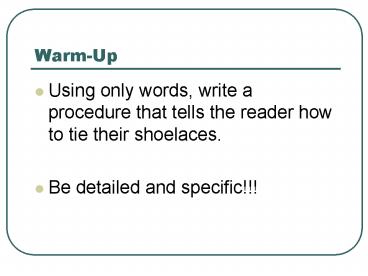WarmUp - PowerPoint PPT Presentation
1 / 24
Title:
WarmUp
Description:
(And a little bit about Beer) This guy drinks rootbeer and look what he can do!!! Biotechnology ... Some of this cure-alls had recipes very similar to rootbeer. ... – PowerPoint PPT presentation
Number of Views:31
Avg rating:3.0/5.0
Title: WarmUp
1
Warm-Up
- Using only words, write a procedure that tells
the reader how to tie their shoelaces. - Be detailed and specific!!!
2
The History of Rootbeer
- (And a little bit about Beer)
3
This guy drinks rootbeer and look what he can
do!!!
4
Biotechnology
- Biotechnology
- Bio means LIFE
- Biotechnology is the manipulation and alteration
of LIFE to develop new processes and products.
5
The Earliest Biotech
- Biotechnology has been going on for THOUSANDS of
years. The most recent Biotech involves the
manipulation of DNA to change genes and create
new proteins. - However WAY before people even knew about DNA
they were doing Biotech. This Biotech had to do
with Food. - Question What do you think were the first things
developed with Biotechnology?
6
The first Beer(You dont need to copy this)
- Over 6000 years ago, a group of people known as
the Sumerians discovered the process of
fermentation and began to make a beer made of
wild barley.
7
What is Fermentation?
- Fermentation is a process that yeast go through
to break down their food. In the process of
fermentation, the yeast consume sugar and produce
Carbon Dioxide. - Question How do you think the Sumerians
discovered fermentation?
8
How does Fermentation Work?
- Yeast use sugar for energy just like we do.
However, they can break it down differently
depending on whether oxygen is present. - If there is NO Oxygen, yeast will go through
fermentation. - Q What will we need to do to our rootbeer to
make sure it goes through fermentation?
9
The invention of rootbeer(You dont need to copy
this)
- In the mid 1800s, many pharmacists made cure-all
remedies that were supposed to treat all sorts of
medical problems. Some of this cure-alls had
recipes very similar to rootbeer. They were made
of roots, spices, and other secret ingredients.
10
The Godfather of Rootbeer(You dont need to
copy this)
- A man named Charles Hires found one of these
recipes that he really enjoyed and began to sell
a packaged version as a tea. - This tea was well received and the Hires family
soon began selling a bottled and carbonated
version. This was one of the first sodas ever
sold.
11
Rootbeer Today
- Most Rootbeer today is made with artificial
flavors and carbonated using machines that inject
Carbon Dioxide gas. - We are going to make Old School Rootbeer we
will use yeast to carbonate our root beer.
12
Designing Writing-Up a Lab
- It is very important to follow the proper steps
for writing up a lab in your notebook. This
ensures that you and others will be able to
easily understand what you did and reproduce your
experiment in the future.
13
Title
- ALWAYS title your experiment. Your title should
tell the reader exactly what your experiment is
about. It should be complete and concise. - Q What would be an appropriate title for the
rootbeer lab?
14
1. Background
- The background section is where you state all the
important information that will help someone
understand the lab. For instance, in the
rootbeer lab well write down what fermentation
is and what is has to do with rootbeer. - NB We are doing this RIGHT NOW
15
2. GOALS
- You should always clearly state the goals you are
trying to accomplish. Your goals should include - QUESTION What are you trying to learn?
- HYPOTHESIS and/or PREDICTION What do you think
is the answer to your question?
16
Good Questions
- A GOOD scientific question is TESTABLE.
- This means that you can design an experiment and
collect data that will help answer your question.
17
Variables
- You will always need to select one variable that
you will change in your experiment. This is your
independent variable. - Changing the independent variable can cause a
change in some of your results. This change that
your observe is your dependent variable. - Always state both variables in your lab.
- Q What could be some ind. Variables for the
rootbeer lab? What would the dependent variables
be?
18
3. Procedure
- Your procedure section should include two
subsections - A. Materials a list of everything that you
will be using, including the proper amounts - Protocol a step-by-step description of how you
will carry out your experiment. - Q What would be the materials for the yeast
balloon lab? What would be a simple protocol?
19
4. Data and Observations
- In this section you record all your measurements,
observations, calculations, and any other
important information that comes from your
experiment. - All information should include labels and
appropriate units!
20
5. Calculations and Graphs
- Using your data, you should make an appropriate
graph that visually represents your results. - Any necessary calculations should be clearly
shown so that someone else could repeat your
procedure.
21
6. Conclusion
- For your conclusion you should include the
following look in your rubric!!! - Results with Evidence and Explanation
- Possible Errors and Explanation
- Practical Applications/Next steps
22
Dont try this at home
23
An interesting note
24
Your task
- In your group, work together to come up with 5
testable questions you could ask about rootbeer.
- For each question, state a hypothesis and the
independent and dependent variable. - Everyone should have their work written in their
lab notebook.































